Presented in partnership with Croatian National Tourist Board
Welcome to Central Croatia, a cradle of culture with a storied past, where idyllic nature and an abundant natural larder collide to sublime effect. While anchored by the country’s buzzy capital, Zagreb, continental Croatia remains somewhat unsung: but for those curious enough to step off the beaten urban track, stunning scenery, medieval towns and a tempting world of flavour await discovery. Join 50 Best as we guide you through the rural region’s culinary wonders, and stay tuned for our guide to eating and drinking in Zagreb in early 2024
Sprawling in a ring from Croatia’s capital, Zagreb’s undulating hinterlands are awash with green. This is a land where time slows; a place in which ancient fort towns and baroque masterpieces daub the hillsides – and where some of the country’s most beloved culinary specialities reside. Sandwiched neatly between Hungary to the north, Slavonia to the east and the natural spectacle of Lika-Karlovac to the southwest, Central Croatia bears influence from its neighbours. Sitting at a culinary crossroads, all who have passed through – from the Czechs, Austro-Hungarians and Slovenians to the Venetians, Ottomans and Romans – have left their signature. But, while influenced by Central Europe, continental Croatia holds firm its idiosyncrasies, many of which are realised from the land itself.
It was here that the upper echelons of Croatian society once flocked to soak up natural beauty, flecking the terrain with palatial summer houses and castles as they went. Today, active travellers are drawn in by tranquil landscapes – dense forests, glistening lakes, thermal springs, towering mountains and pretty meadows – which offer ample opportunity for the likes of cycling, hiking, fishing and horse riding. They’ve probably been keeping the marvels of the region to themselves. Little wonder: part of the region’s charm comes from a sense of unblemished authenticity that’s imbued into every element of life here – something most evident in the quality of its cuisine. To journey deeper is to be rewarded with a food scene full of surprises that lives and breathes a farm-to-fork ethos, just as it has for centuries.
Refined rusticism
In an enticing land where baroque mansions are fringed by pastures speckled with old shepherds’ huts, expect a harmonious marriage of flavoursome country fare and old-school bourgeois refinement. Whatever you choose to devour, rest easy in the knowledge you’re getting an authentic taste of a region venerated by its chefs and cooks.
Central Croatia’s foodways are a palate-pleasing tale for all seasons. Summer is a time for fresh salads, fantastic savoury pastries and cold cuts of boiled ham with sir i vrhnje (local cottage cheese), cooling dollops of smetana (sour cream) laced with paprika, wild chives and maize-based breads. As you’d expect of such a pastoral land, the dairy here is unrivalled. The protected, conical prga cheese (a speciality of Bilogora-Podravina) is a true food hero: paprika is added to the fresh cow’s milk during the process, which then sees the cheese smoked and air-dried for ultimate flavour. 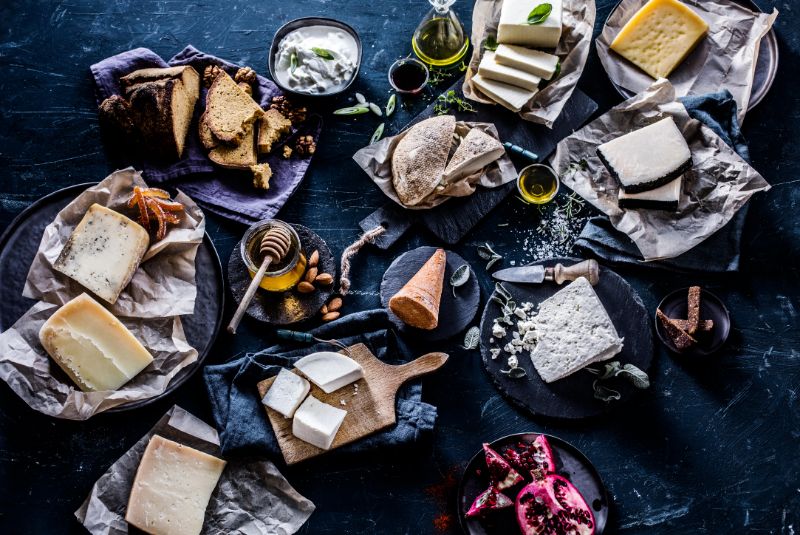
Central Croatia is lauded for its exemplary dairy products (Image: Maja Danica Pečanić, courtesy of Croatian National Tourist Board)
Comforting one-pot creations like Samoborska kotlovina – a divine mix of pork, onion and root veg slow-cooked in wine – is emblematic during the colder months. Different areas have their own variations, perhaps using sausages, veal or game, but Samobor’s expression is the one the gourmet cognoscenti have long returned to. Then there’s tripice – or špek fileki, as it’s sometimes known: tripe simmered with onions, bacon and tomatoes. In the south, the soup-like sauce is poured over slow-cooked polenta; elsewhere it’s dished up with pasta or simply hunks of bread to mop up all the glossy juices. While tripice might not be to everyone’s taste, it deserves at least a try when travelling through the region.
Less divisive is krpice sa zeljem – pasta and cabbage cooked in pork lard – a perfect foil for roast meats or sausages. The same is true of the restorative thick sausage and bean stews that bubble over open flames and scent the landscape. Bursting with flavour, they form the ideal fodder to bolster days in the Međimurje mountains. An excellent waypoint for those in the area is Restaurant Terbotz, set on the Jakopić estate on the picturesque Železna Gora hillside: the estate garden and surrounding forest are the driving force behind a model menu of Međimurje cuisine. Less than 20 minutes’ drive away, Mala Hiža is another sure-fire recommendation. Housed in a charming oak building that was transported and reconstructed in the middle of an orchard in 1997, the family-owned eatery serves produce-driven creative cuisine, accompanied by a hyper-local wine list.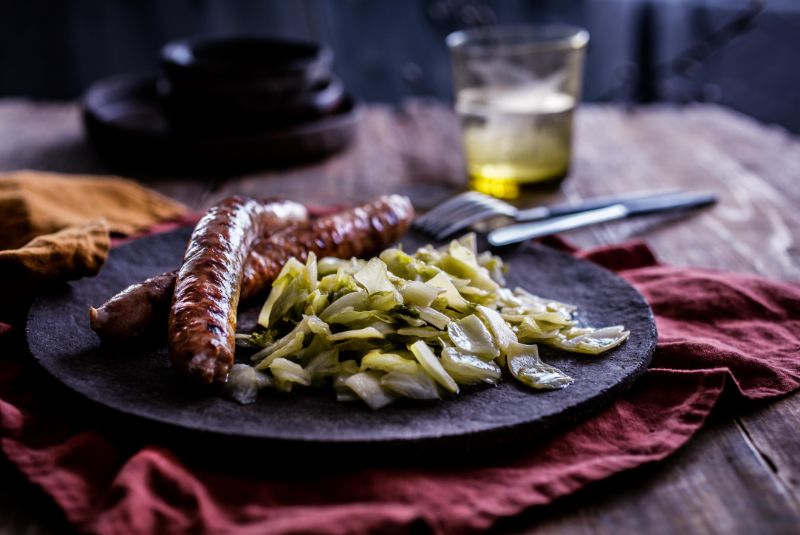
Krpice sa zeljem is a traditional dish of cabbage and pasta simmered in lard (Image: Maja Danica Pečanić, courtesy of Croatian National Tourist Board)
Around the baroque town of Varaždin, wild game in rich, elaborates sauces is the order of the day – a vestige of the grandiose Austro-Hungarian days. Meanwhile, purica s mlinci is the flagship dish of Zagorje, the hilly region north-west of Zagreb. A favourite across the whole province, plump turkey is roasted in its own fat and served with flat ribbons of pasta which are crisped up in the meat pan as the bird rests. It’s believed that turkey was introduced to the area by the Paulines in the 1500s, and such delicacy was later served in the royal courts of Vienna and England to much acclaim.
Krapina town’s winery hotel Vuglec Breg is a good place to try it for yourself. The timber-clad restaurant comes with sweeping views and reveals other local morsels like Zagorski štrukli. Served as a starter, snack or alongside soup, think of it as a savoury, doughy pastry filled with a mix of cottage cheese, sour cream and eggs, then sprinkled in breadcrumbs and cooked. Or head to Grešna Gorica, a rustic spot that acts as a regional museum while dishing up all the area’s favourite plates.
Nurtured by nature
In the atmospheric forests of Turopolje, south of Zagreb, mushrooms and truffles to rival those of Istria are snuffled out by one of the oldest indigenous pigs. The pig’s high-quality meat also makes its way to the table, and the area is known for some of the most outstanding duck and goose. Ideal with rich meats, the flavour of Ludbreg’s horseradish is unrivalled and it’s used frequently to add punch to anything from ham and eggs to roasts, salads and winter preserves (of which there are many).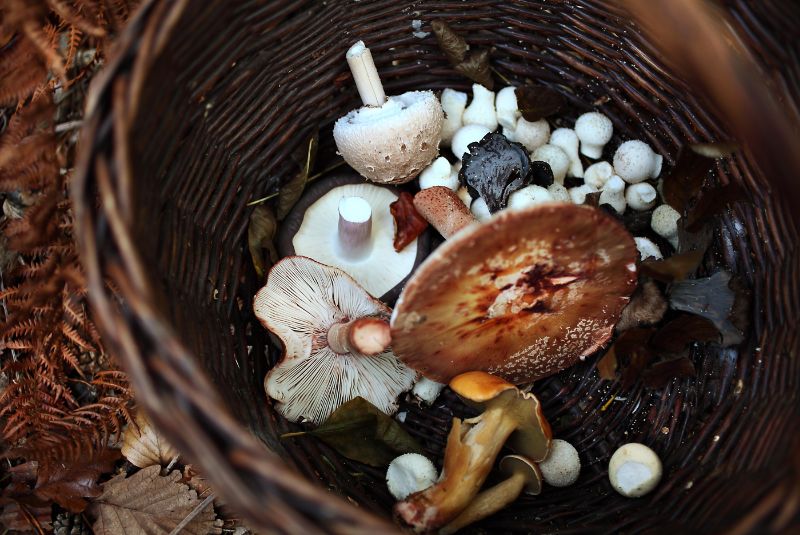
The forests of Turopolje are famed for their mushrooms and truffles (Image: Maja Danica Pečanić, courtesy of Croatian National Tourist Board)
Further south, Moslavina is considered pumpkin country. The gourd presents itself in the form of seed oil used generously across salads and alongside cold platters, as well as in bučnica. These strudel-style pockets are filled with cheese, sour cream, grated pumpkin (the young ones of the summer are best) and pumpkin seed oil, with the crisp exterior yielding to soft, savoury deliciousness. Follow your nose to Desinić’s annual Bučnica Fest competition to see how it’s done – and don’t miss the October pumpkin festival in Ivanić Grad.
Elsewhere, corn is so intrinsic to the life of locals that Posavina even has its own maize. It is used in zlevanka, a dish integral to Central Croatian tables – a dense cornbread-style pudding served both savoury and sweet, either with the addition of cheese or apple, walnuts and jam. It’s slow food from a land that truly provides.
A spoonful of sugar
You don’t need to dig too deep to find a sweet delicacy in these parts. Keep your eyes peeled for gibanica – a sweet layered pastry cake featuring apple, poppy seeds, walnuts and cheese, which was originally cooked in clay pots. The order in which the layers should be stacked continues to be debated across the region today.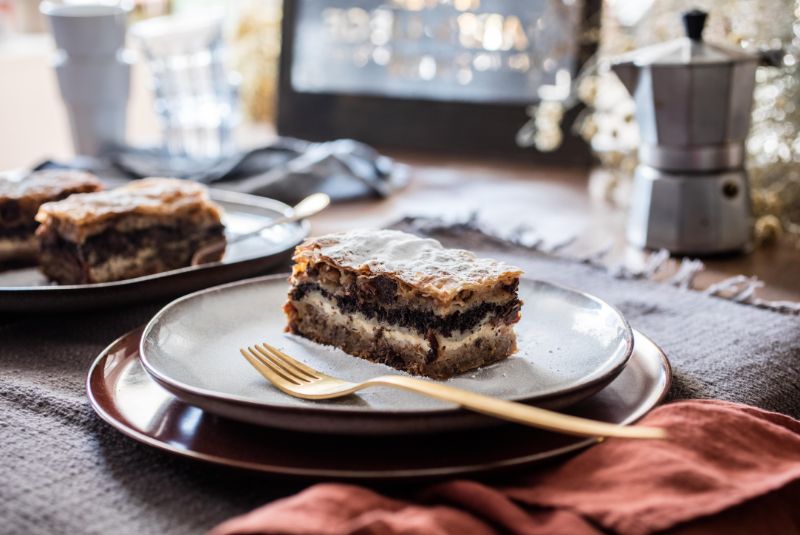
Međimurska gibanica is one of the country's favoured sweet treats (Image: Maja Danica Pečanić, courtesy of Croatian National Tourist Board)
Samoborske kremšnite, meanwhile, is still made using the original recipe from Đuro Lukačić, who was inspired by his time studying in Vienna and Budapest. A light vanilla custard slice of sorts, it’s a tempting special from the city of Samobor. Krafne is another Austro-Hungarian inflection: a rich doughnut filled with sweet cream and warm apricot or plum jam. And the štrudle is a stalwart, filled with cherry or apple depending on the season. Surplus apples can be found in šlafrok (literally: nightgown) – ringed and dunked in batter before being fried. What’s not to love?
Word on the vine
Continental Croatia’s drinks scene is driven by the incredible terroir and favourable microclimate of the Croatian Uplands (Bregovita Hrvatska). From the fresh white pušipel found in Međimurje and the dry, sparkling kraljevina, signature of Prigorje and Zagorje, to the ancient škrlet of Moslavina (with its floral nose and herbal notes) and Plešivica’s orange muscat – there’s really a wine for everyone. And that’s before you’ve even considered gvirc…
Luscious vineyards line the hills of Zagorje (Image: Ivo Biočina, courtesy of Croatian National Tourist Board)
Gvirc (mead) is a delicious buzzword around here. It’s one of the world’s oldest drinks: historically it was made by local beekeepers using grape must, and sold at county fairs and festivals. The dark, amber chestnut honey typical of production today sings of the region. It’s perhaps most popular in Samobor, where it’s often served in place of a sweet wine with dessert.
The town also acts as vanguard to the aromatic bermet – a sort of hybrid dessert wine/herbal liqueur. It’s made from blue frankisch grape must muddled with a litany of spices and botanicals (clove, nutmeg, liquorice and mugwort), citrus zest, carob and dried fruit. At one time, every household would craft their own. A bittersweet edge makes for an ideal digestif.
Native poet Antun Gustav Matoš declared Samobor ‘the most Croatian of Croatian towns’. Dating back to 1242 and just 20km from Zagreb, on the eastern slopes of the Samoborsko Gorje range, it offers incredible baroque architecture and welcoming hosts. Immerse yourself at Salvator in the traditional confines of Hotel Livadić. The tavern-like dining room is tucked away in the old cellar, offering an atmospheric framework for the likes of štrukli Livadić, platters of boiled ham, Samobor salami and cheese, slow-roasted veal and buncek (ham hock).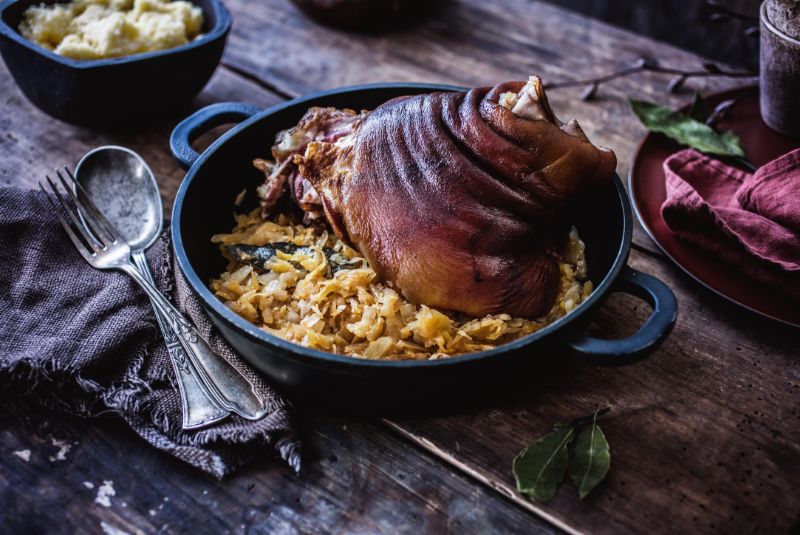
Braised buncek (ham hock) is a regional specialty (Image: Maja Danica Pečanić, courtesy of Croatian National Tourist Board)
Or you could try Gabreku 1929, a name indicative of its time at the helm of Samobor’s dining scene. Facing the church of St Michael at the edge of the Old Town walls, an outdoor terrace is perfect for clement days. The menu follows original home recipes dating back to its inception, all prepared with local ingredients. Don’t miss the tempting bučnica. From here, immersing yourself in nature is a breeze: the stunning Žumberak Nature Park and Samobor Highlands are within striking distance.
Bastions of tradition
On the outer edge of Žumberak Nature Park are the loping vines of Plešivica wineland. Vina Braje is a choice table to book. The charming restaurant feels like stepping into a family home, with an offering that channels the same cosseting sentiment. Homespun and hearty, it conveys real sense of place.
It's a fact that restaurateurs here take their work seriously: consider them champions of regional fare. Inviting Zelenjak is beloved for its fine line in homemade Zagorje fare, while the food at Petrijanec hunter’s lodge, Zelendvor, is both incredibly fresh and incredibly delicious. Anđelko Pomper, of Zlatne Gorice, is a master of the classics: try his Goric platter of home-cured specialities, his goose liver pâté or his venison stew and you’ll see why. The restaurant with rooms is enveloped by nature close to Varaždin, with dramatic panoramas of the town beyond best witnessed from the lofty dining room.
Žumberak Nature Park offers abundant beauty and exemplary dining options (Image: Ivo Biočina, courtesy of Croatian National Tourist Board)
Meanwhile, Mihanović Mansion – in Tuheljske Toplice – charms with modern iterations of traditional fare. Think štrukli, polenta and mlinci with a twist; they also hero noble dishes inspired by the mansion’s former owner, Count Brigljević. It’s a similar story at Mala Hiža – nestled on the site of an old orchard near Mačkovec – where chef Branimir Alexander Tomašić is a keen purveyor of neo-rustic bourgeois cuisine.
Bolfan Vinski Vrh, in Hrašćina, is another fail-safe. Chef Marija Turek works with a low-food-mile mantra to form a creative menu grounded in heritage dishes with a contemporary edge. Balanced on a hilltop surrounded by vines, it’s a spectacular setting that could easily be mistaken for Tuscany. And make time for a meal at Restaurant Bedem: chefs Anđelko Levanić and Zlatko Novak are leading lights of new Varaždin cuisine.
Gablec: a culinary institution
Don’t be surprised to see the term ‘gablec’ chalked up on daily menus. As is true of any great food culture, customs extend to more than simply what’s served on the plate and Central Croatia is no different. The revered institution of gablec holds as much social significance as that of pinxtos in Spain’s Basque Country. Centred around a mid- to late-morning meal, it’s more than what you might expect from an American brunch or England’s ‘elevenses’. This widespread custom – sometimes also called ‘marenda’– is all about soulful sustenance.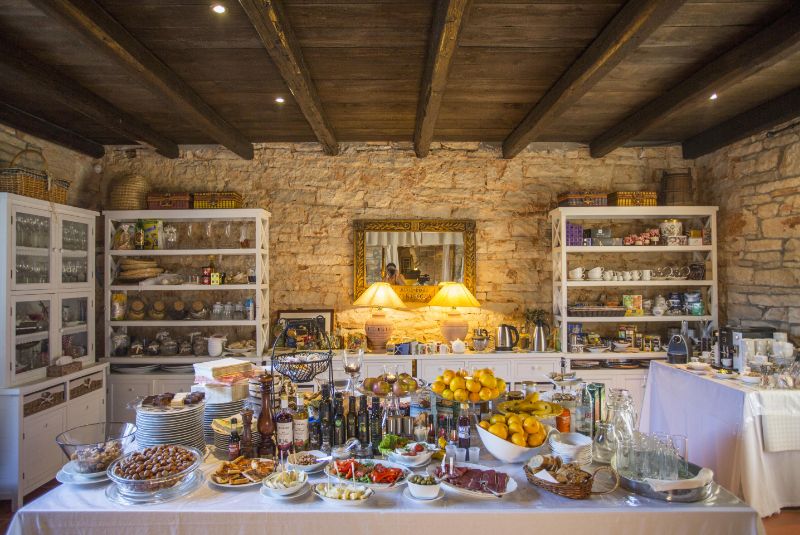
Gablec is a brunch-style meal with a focus on hearty local dishes (Image: Marko Vrdoljak, courtesy of Croatian National Tourist Board)
Rooted in pastoral traditions (it was originally a cheap meal for workers) and a zero-waste mantra, there are no hard and fast rules. Flavoursome bowls might include bean soup with garlic sausage or prosciutto off-cuts, maybe tripice or Hungarian-leaning paprikash. Fresh homemade bread is essential for mopping up the juices. It’s typically served with gemišt, a glass of local white lengthened with mineral water. Try it at the likes of Bjelovar’s modern Bistro Franz or at Restauran Garfield in Ivanić Grad, which extends a contemporary play on the tradition with a least three daily choices. Because what gastronome doesn’t like an excuse to include another meal into a day of gourmet travels?
The man blazing a gastronomic trail
While Central Croatia’s gourmet wonders may yet sit in the ‘insider knowledge’ camp, that’s set to change. Putting Zagreb County on the epicurean map, and piquing global interest, is chef Bernard Korak. His eponymous restaurant sits resplendent in the bucolic wine region of Plešivica and is considered the first bona fide fine-dining restaurant in the Croatian Upland area. As it’s part of the family’s lauded winery in Jastrebarsko, excellent graševinas, chardonnays and pinot noirs are paired with Korak’s exquisite five- or eight-course degustation menus.
But there’s more to the story. Korak is as emphatic in his commitment to honouring local culinary traditions as he is in his love of the region’s distinct terroir. Two kitchen gardens fuel the sustainable menu, backed by top-class produce from a network of local growers, foragers and hunters. The rule is: if it’s not in season, it’s not on the table. It makes sense when you discover that he cut his teeth in the kitchens of Hiša Franko – under The World’s Best Female Chef 2017, Ana Roš – and with Massimo Bottura at Osteria Francescana, a previous No.1 on The World’s 50 Best Restaurants list.
View this post on Instagram
The result is pure gastronomic alchemy and a real snapshot of the region. Served in a contemporary dining room – all floor-to-ceiling windows with views over the vines and Sava plain beyond – the menu is grounded in Korak’s grandmother’s recipes, which he brings up to date for the modern palate, while remaining true to their heritage. A wise move, as she occasionally lends a hand in the kitchen making the curd to fill the delicate pockets of his signature tortellini. Nuanced flavours and pretty, accessible presentation are showcased across the pitch-perfect menu. Notable plates might include zander laced in brown butter with wild garlic; homemade cured meats and sourdough with hand-churned sour cream cultured butter and venison carpaccio, served with walnut liqueur and blueberry balsamic.
A play on elevated country classics, if you will, this is one to watch. Because that’s the thing about continental Croatia. As it advances, it turns ever-more to its roots. The result is as enticing as it is delectable. Get there now – before everyone else does.
Continue your journey around Croatia’s delicious food and drink on croatia.hr.
Browse even more restaurant and bar recommendations across the world on the 50 Best Discovery website, and follow 50 Best on Instagram, Facebook, X and YouTube for the latest news, features and videos.

